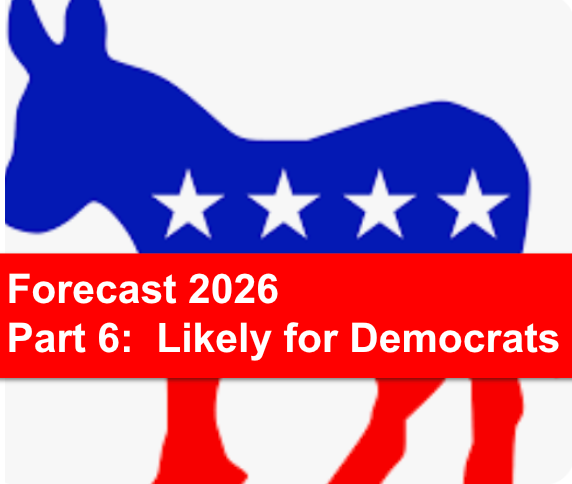There are three likely Democratic Senate seats up for grabs in 2026, starting with Minnesota.
MINNESOTA
Tina Smith, the incumbant Democrat, is serving her first term; she was elected in 2020, but was first elected in a special election two years prior.
In 2020, Smith won by a somewhat underwhelming margin of around five points, but this can be attributed to a third-party candidate in Minnesota garnering nearly 6% of the vote.
Now, going to take that into consideration when making predictions, which I intend to do.
But think about Minnesota; it's pretty notorious for holding the longest Democratic voting streak in the nation on the presidential level.
It hasn't gone Republican since 1972, when Richard Nixon won 49 states in his reelection victory.
And while that may paint the picture that Minnesota is deeply Democratic, in the likes of Vermont or Rhode Island, for example, it really bears more resemblance to other neighboring Midwestern states like Michigan or Wisconsin.
However, while Michigan and Wisconsin are marginal and are considered at the forefront of the presidential battleground, or on the Senate battleground, or on the House or gubernatorial battleground, Minnesota is usually on the fray of that arena.
Minnesota went for Joe Biden by around seven points, and in 2022, Democrats won the governorship by a very healthy margin.
In 2026, while a strong Republican, combined with a third-party presence detrimental to Democrats, I could see Tina Smith, potentially face a close election, maybe she’ll be forced into an under a five-point victory, and the best case scenario for Republicans. But ultimately, the prospect of Smith losing an election in a state where Democrats haven't lost the presidential in over 50 years, and where Democrats haven't lost a Senate seat since, and at least 20 years, it's difficult to imagine - and challenging to see 2026 finally being the Republican breakthrough in Minnesota.
VIRGINIA
My second likely Democratic prediction is in Virginia.
Now, Virginia, for quite a long time in its history, had been a firmly Republican state.
From around 1964 to Obama's victory in 2008, Virginia had voted for Republicans on the presidential level without fail, every single time.
Now, when Obama finally won the state in 2008, that really cemented its leftward shift. It's gone for the Democrats in every presidential election since, and has only really increased in margin of victory, going from Obama's around 6-point victory in 2008 and 4-point victory in 2012.
Hillary Clinton, in fact, surprisingly improved on Obama’s 2012 performance, winning the state by nearly five points.
In 2020, Joe Biden arguably reached the Democratic ceiling in that state, for now, by winning Virginia by over 10 points against Donald Trump.
The Democratic gains in the state were largely fueled by the suburbs, particularly around Washington, D.C., in Northern Virginia, shifting exponentially blue, especially in reaction to Trump's inflammatory rhetoric and personal failings, to the candidate, as well as the GOP's embrace of extremism, as a whole.
Now, Democrats are very capable of losing in Virginia.
This can be seen in 2021 when Democratic governor candidate Terry McAuliffe lost to Republican Glenn Youngkin in a surprise loss.
But that election had more to do with Joe Biden's sagging approval at the time, possibly that made Virginia appear more red than it actually is.
In 2022, Democrats returned to form slightly.
There was no federal election to support this, but in the House elections, Democrats retained all but one of their seats and successfully won a very competitive House election, protecting one of their incumbents, Abigail Spanberger.
While Democrats may not win Virginia by 10 points in 2024, I personally argue that they wouldn't by less, possibly like a fair amount less, like I could see Democrats winning Virginia by only around five or six points.
If the election plays out with a Republican victory, I ultimately think that Virginia is unlikely to go to the Republicans in 2026, regardless of how bad the circumstances are for Democrats.
It's at that point where the state is too much to the left that it would take a really, it would take a really gigantic national event, or a really talented Republican candidate, and a really flawed Democratic one, to really make the elections seriously competitive or put it in toss-up territory.
NEW HAMPSHIRE
It's a similar story up in New Hampshire, which is the least Democratic of the New England states, even more so than Maine.
But Democrat Jeanne Shaheen is very strong.
She won her last election in 2020 by over 16 points.
It's unlikely that Republicans will even bother to really put up a huge fight in the state, considering their previous candidate in 2022, Don Bolduc, lost by nine points, despite some polls showing him in the margin of error, or even winning that election.
Simply put, New Hampshire has been a swing state for many, many years.
It has shifted to the left to the point that you could pretty reliably say, or bet money on the fact that it's going to go Democrat in any given election.
Click here to read Senate 2026: Part 7

